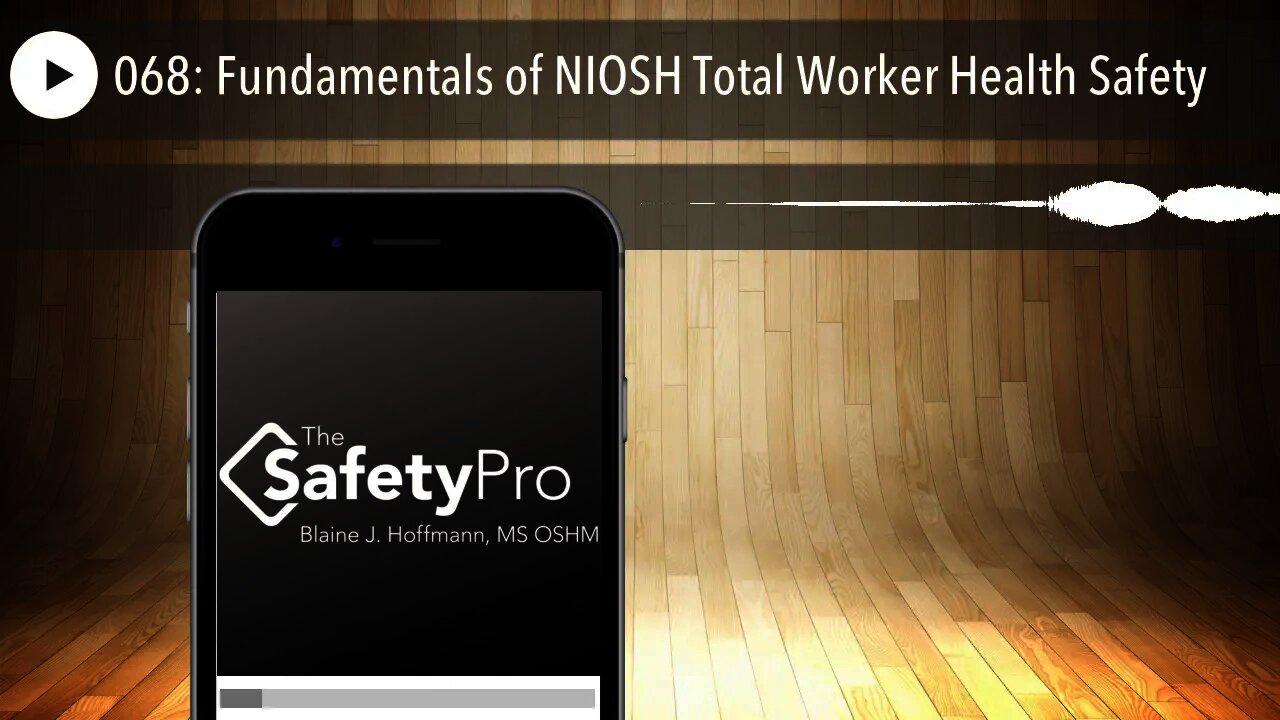Premium Only Content

068: Fundamentals of NIOSH Total Worker Health Safety
Subscribe here:
http://www.thesafetypropodcast.com
Powered by iReportSource
Fundamentals of Total Worker Health
Keeping workers safe is the foundation upon which a TWH approach is built. Total Worker Health integrates health protection efforts with a broad spectrum of interventions to improve worker health and well-being.
The Fundamentals of Total Worker Health Approaches is the practical starting point for employers, workers, labor representatives, and other professionals interested in implementing workplace safety and health programs aligned with the Total Worker Health (TWH) approach. There are five Defining Elements of TWH:
Element 1: Demonstrate leadership commitment to worker safety and health at all levels of the organization.
Element 2: Design work to eliminate or reduce safety and health hazards and promote worker well-being.
Element 3: Promote and support worker engagement throughout program design and implementation.
Element 4: Ensure the confidentiality and privacy of workers.
Element 5: Integrate relevant systems to advance worker well-being.
Getting Started
Create a team of people who know about different policies, programs, and practices in your workplace that impact worker safety, health, and well-being. Draw team members from all levels of the workforce, and consider including the following:
• workers who have requested or participated in changes for safety and health safety directors
• human resources representatives
• occupational health nurses or other healthcare practitioners
• workers’ compensation professionals
• Employee Assistance Program professionals
• staff responsible for disability management and return-to-work procedures health and wellness champions.
Defining Element 1: Demonstrate leadership commitment to worker safety and health at all levels of the organization
Organizational leaders should acknowledge and communicate the value of workforce safety and health as a core function, and they should prioritize worker safety and health on the same level as the quality of services and products.
ProTip: Middle management is the direct link between workers and upper management and plays a critical role in program success or failure. For example, supervisors often serve as gatekeepers to employee participation in programs, and when program involvement competes with productivity demands, they may discourage employee participation
Effective programs thrive in organizations that promote respect throughout the organization and encourage active worker participation, input, and involvement. Leaders at all levels of the organization can help set this tone, but everyone (from managers down to front-line workers) plays an essential role in contributing to this shared commitment to safety and health. Beyond written policies, stated practices, and implemented programs that endorse safety and health in your workplace, consider the extent to which your organization’s spoken and unspoken beliefs and values either support or deter worker well-being [CPWR and NIOSH 2013].
Encourage top leaders to:
• Establish and communicate the principles of the proposed initiative to all levels of the organization; teach managers to value workers’ input on safety and health issues.
• Maintain the visibility of the effort at the organization’s highest levels by presenting data that is linked to the program’s resource allocations. Promote routine communications between leadership and employees on issues related to safety, health, and well-being.
• Openly support and participate in workplace safety and health initiatives. Facilitate participation across all levels of the workforce.
• Add safety and health-related standards into performance evaluations. Build safety and health into the organization’s mission and objectives. Establish a mechanism and budget for acting on workforce recommendations. Emphasize that shortcuts must not compromise worker safety and health.
• Provide adequate resources, including appropriately trained and motivated staff or vendors, space, and time. If necessary, ensure dedicated funding over multiple years, as an investment in your workforce.
Encourage mid-level management to:
• Recognize and discuss the competitive advantage (e.g., recruitment, retention, employee satisfaction, community engagement and reputation, and workforce sustainability) that TWH brings to the long-term sustainability of the organization.
• Highlight examples of senior leadership’s commitment to TWH.
• Provide training on how managers can implement and support Total Worker Health–aligned approaches, such as those related to work-life balance.
Defining Element 2: Design work to eliminate or reduce safety and health hazards and promote worker well-being
A Total Worker Health approach prioritizes a hazard-free work environment for all workers. It applies a prevention approach that is consistent with trad
-
 32:14
32:14
daniellesmithab
16 hours agoNew Feature for Driver’s Licence and ID Cards
1035 -
 2:54:40
2:54:40
FreshandFit
13 hours agoChat Makes Pothead RAGE QUIT!!!
451K63 -
 1:32:34
1:32:34
Badlands Media
15 hours agoBaseless Conspiracies Ep. 150: 9/11 Mysteries, Remote Pilots, and Hidden Agendas
91K33 -
 5:32:35
5:32:35
Akademiks
7 hours agoWHERE IS WHAM????? Thug we Forgive u dawg.. Ralo vs Boosie. Charlie Kirk fallout. Cardi B album?
70.8K7 -
 2:05:53
2:05:53
Inverted World Live
8 hours agoDeath Cult Terror Cells, NASA Bans Chinese Nationals | Ep. 108
68K11 -
 2:43:57
2:43:57
TimcastIRL
9 hours agoVP Says No Unity With Democrats Celebrating Charlie Kirk Assassination, Left Confirmed | Timcast IRL
292K193 -
 13:45
13:45
The Charlie Kirk Show
8 hours agoTPUSA AT ASU CANDLELIGHT VIGIL
232K68 -
 55:10
55:10
Katie Miller Pod
8 hours ago $16.71 earnedEpisode 6 - Attorney General Pam Bondi | The Katie Miller Podcast
109K34 -
 1:46:41
1:46:41
Man in America
13 hours agoLIVE: Assassin Story DOESN'T ADD UP! What Are They HIDING From Us?? | LET'S TALK
88.7K125 -
 2:24:17
2:24:17
Barry Cunningham
9 hours agoFOR PRESIDENT TRUMP WILL TAKE NO PRISONERS AND THE LIBS SHOULD EXPECT NO MERCY!
124K77